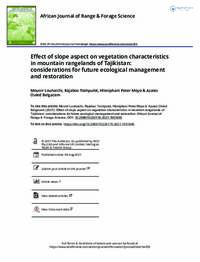Effect of slope aspect on vegetation characteristics in mountain rangelands of Tajikistan: considerations for future ecological management and restoration

Authors:
Tajikistan’s rangelands are mostly mountainous and consist of summer and winter pastures. Vegetation structure and composition in these diverse landscapes are generally influenced by environmental factors. The objective of this study was to assess the effects of aspect on vegetation characteristics of two mountainous pastures (summer and winter) over two seasons (autumn and spring) in Tajikistan. A three-way ANOVA was conducted using GLM procedures to test the main effects and interactions of these factors on vegetation attributes. The biomass production (kg DM ha−1) was significantly greater on the north-facing aspects for both summer and winter pastures in spring (483.4, 326.1) and autumn (57.2, 143.9), compared with south-facing aspects (57.2, 143.9 in spring and 18.5, 48.2 in autumn, respectively). Plant cover and plant density were also greater on north than south-facing slopes for summer and winter pastures in spring and autumn. Aspect significantly affected species diversity, botanic composition, and plant life forms of both pastures mainly for grasses and geophytes. There were greater vegetation responses on north than south-facing slopes, implying that aspect is important when designing mountain rangeland restoration. Given this complexity, land managers should thoroughly assess the conditions of the target site before defining restoration objectives and interventions.
